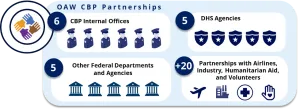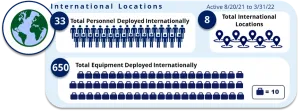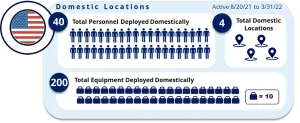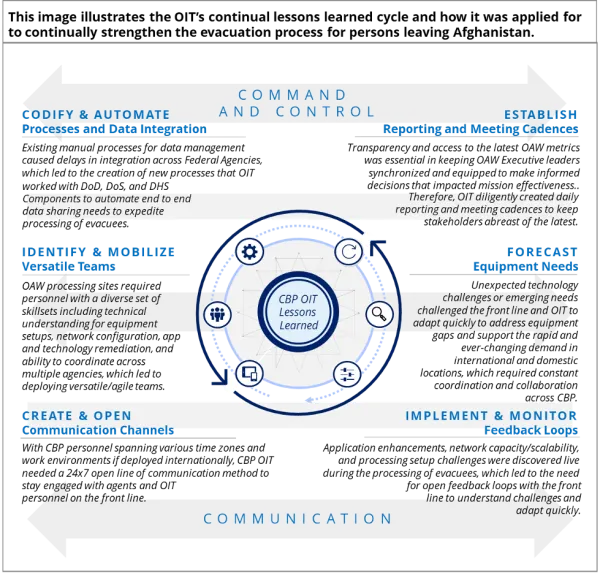On Aug. 14, 2021, the Taliban took control of the city of Kabul, the capital of Afghanistan. Shortly thereafter, President Joe Biden announced the U.S. would be evacuating over 100,000 people from Afghanistan. U.S. Customs and Border Protection (CBP), alongside other federal agencies, responded to the rapid withdrawal from Afghanistan and mobilized a comprehensive campaign called Operation Allies Welcome. CBP was asked to support OAW by providing personnel and technology to aid in processing evacuees.
Office of Information and Technology (OIT) personnel deployed across the U.S. to provide around-the-clock support at processing centers, airports and to international sites over the span of seven months, partnering with CBP officers and staff from the Department of Defense, the State Department, the Transportation Security Administration, and the FBI. More than 650 pieces of equipment and over 200 OIT personnel participated in this effort.
“Our team was overjoyed to support. The entire effort is really an investment in the America of tomorrow,” said OIT Deputy Assistant Commissioner Dr. Ed Mays.
OIT staff demonstrated unwavering dedication despite challenges that required quick adaptation of technology to meet urgent needs. International OIT staff met critical processing requirements, served as translators, and coordinated the distribution of resources for evacuees. Teams set up processing stations and configured networks and equipment to expedite the returns of evacuees as quickly as possible.
“OIT did an incredible job. You know, they had to wire a hanger to be a port of entry, and they got that done in days. I can't tell you how effective they were as part of the CBP family!” Air and Marine Operations Deputy Executive Assistant Commissioner Dennis Michelini wrote in praise of OIT efforts.
OIT continued to be instrumental in supporting the ongoing Operation Allies Welcome effort. CBP worked domestically with airport authorities, air carriers, and multiple government agency partners to set up processing facilities and centers for evacuee arrivals. OIT developed several new solutions to process evacuees from Afghanistan. These included biometric and biographic collection, targeting and vetting, data stream consolidation data and information sharing with partner agencies, and subsequent validation of vetting results using photo comparison services.
OIT developed a new process to capture all CBP biometric and biographic enrollments from locations outside of the U.S. and subsequently merge with enrollments received from partner agencies. A new process was also developed to ingest vetting results received from partners and merge with those into a central repository. Using the CBP enterprise facial matching technology, OIT was able to leverage photos from biometric enrollments to build a photo gallery of individuals who cleared the vetting process. CBP personnel were able to verify vetting results using facial matching technology and allow boarding of flights to the U.S.
OIT created a modular, interactive Operation Allies Welcome dashboard to provide statistics on passengers arriving to the U.S. Dashboard statistics provide the Department of Homeland Security and CBP management and officers in the field close to real time updates on Primary and Secondary processing of Afghanistan evacuees, unaccompanied minors, and U.S. citizens. In just three months, CBP leaders, staff, and government partners accessed the dashboard 1,650 times. OIT created numerous reports to provide enrollment and vetting status and provided critical support to help identify American citizens and Lawful Permanent Residents who were still in Afghanistan and in need of evacuation.
“In my 30+ years working in government IT systems, I have never seen such a tremendous effort by any workforce to complete a mission,” said OIT Assistant Commissioner Sanjeev “Sonny” Bhagowalia. “I have been humbled and astounded at the capabilities of the OIT personnel. This would not have been possible without their systems and application knowledge, experience and commitment, and their unwavering dedication to the CBP Mission.”
As of today, OIT continues to provide 24/7 operational coverage, making numerous improvements to software programs and mobile applications, as well as creating interoperability between government agency partners. To date, over 86,000 evacuees have been processed, helping to deliver travelers to a safe haven.





